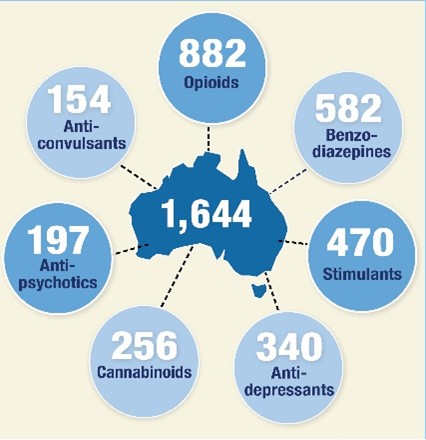International Overdose Awareness Day (IOAD) is held on the 31 August every year and seeks to create better understanding of overdose, reduce the stigma of drug-related deaths, and create change that reduces the harms associated with drug use.
Local communities in Australia and around the world come together to remember those who have died or suffered permanent injury due to drug overdose.
The Pennington Institute's Australia's Annual Overdose Report 2021 reveals that there have been 34,728 overdose deaths in Australia since the turn of the century. Deaths from overdoses have outnumbered the road toll since 2014.
Of the 2,227 overdose deaths in Australia in 2019 - 1,644 were unintentional.
This infographic breakdowns the different drug types that caused those overdose deaths.

According to the UN Office on Drugs and Crime's most recent World Annual Drug Report, nearly half a million people around the world died as a result of drug use in 2019.
What is an overdose?
An overdose means having more of a drug (or combination of drugs) than your body can cope with. There are a number of signs and symptoms that show someone has overdosed, and these differ with the type of drug used. All drugs can cause an overdose, including prescription medication prescribed by a doctor. It is important to know the right amount and the right time to take your medication. It is also vital to know what drugs should not be mixed, and to seek help if you feel you are not in control of your drug use.
Naloxone - life-saving opioid overdose-reversing drug
Accidental opioid overdose continues to be a significant cause of death in Australia and the opioid overdose-reversing medicine, naloxone is available for free in NSW. Naloxone is a short-acting opioid antagonist that reverses the effects of an opioid overdose.
When an opioid overdose happens, a person's breathing slows down or completely stops, leading to rapid loss of consciousness and potentially death if help is not given in time. Naloxone works by binding to the opioid receptors in the brain, blocking the effects of opioids.
When administered in time, naloxone can temporarily reverse the effects of an opioid overdose, enabling the person to breathe normally while waiting for an Ambulance to arrive.
Naloxone is available in NSW for free for anyone at risk of witnessing or experiencing an opioid overdose. Anyone can receive free naloxone without a prescription from community pharmacies, non-governmental organisations (NGOs) and NSW Needle and Syringe Programs (NSP) registered in the take home naloxone program.
Go to Take Home Naloxone for further details, including a list of participating pharmacies, NGOs and NSPs.
For further information and to request Australia's annual overdose report 2021, visit https://www.penington.org.au/publications/australias-annual-overdose-report-2021/
Are drugs a problem for someone you care about? Contact Family Drug Support (FDS) for 24 hours, 7 days a week phone support on 1300 368 186 or visit fds.org.au.
For free and confidential advice 24/7 Alcohol and Drug Information Service (ADIS) on 1800 250 015. Counsellors are available to provide information, referrals, crisis counselling and support. Or start a Web Chat with an ADIS counsellor online Monday to Friday, 8.30am – 5pm.
